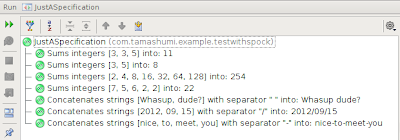Classloader problem with Java 7 and WebServices in Grails
Our Grails 2.1 application communicates with external SOAP WebServices. It worked fine as we follow Software Guy's advices from this blog post. Recently, our client required new functionality - export to Excel. We've used Apache POI libraries for expor... Read more
 Couple of years ago I wasn't a big fan of unit testing. It was obvious to me that well prepared unit tests are crucial though. I didn't known why exactly crucial yet then. I just felt they are important. My disliking to write automation tests was mostly related to the effort necessary to prepare them. Also a spaghetti code was easily spotted in test sources.
Couple of years ago I wasn't a big fan of unit testing. It was obvious to me that well prepared unit tests are crucial though. I didn't known why exactly crucial yet then. I just felt they are important. My disliking to write automation tests was mostly related to the effort necessary to prepare them. Also a spaghetti code was easily spotted in test sources.
